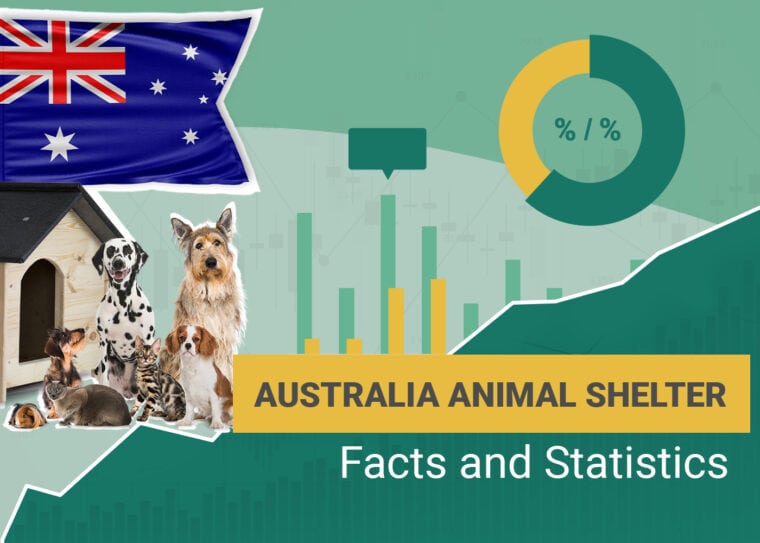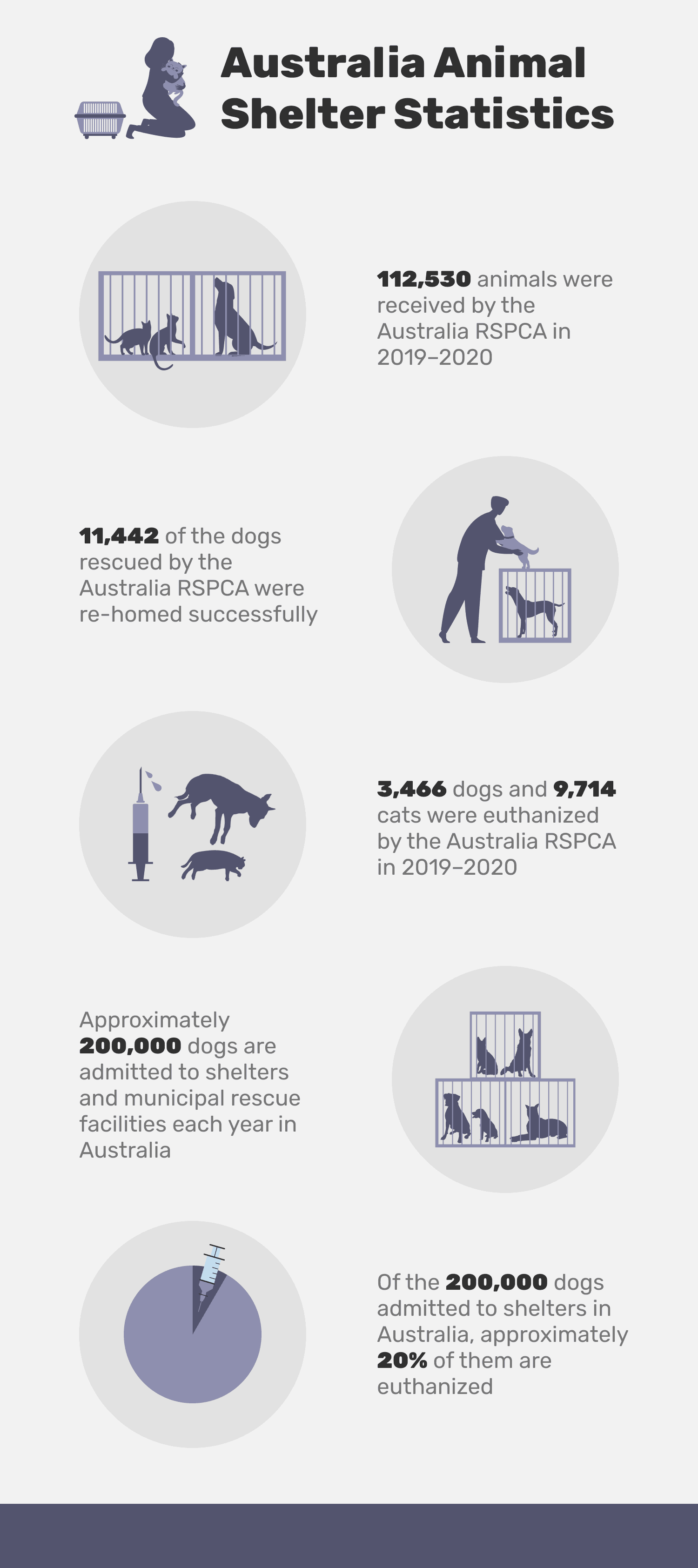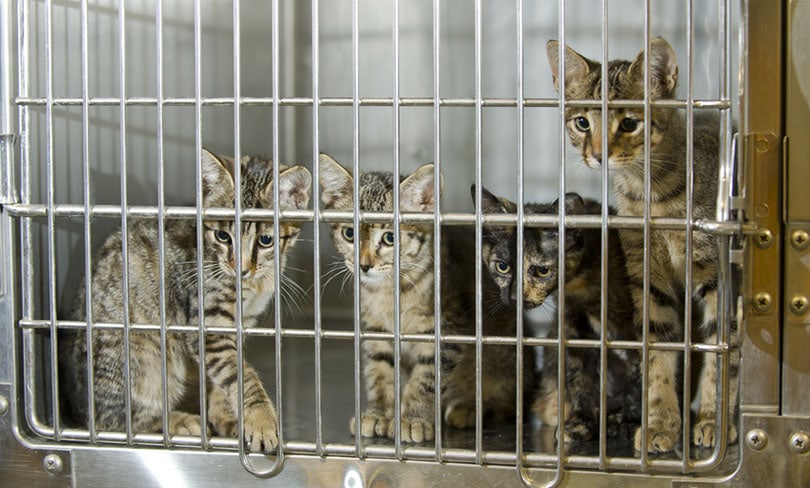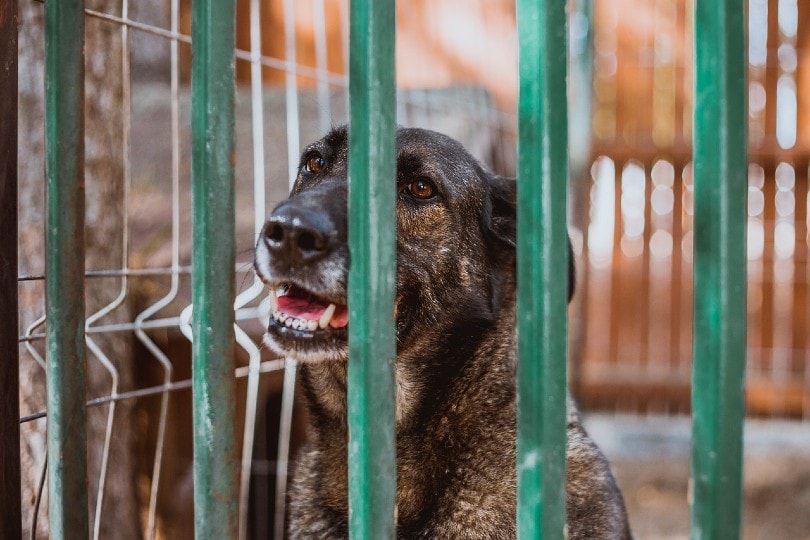
Click to Skip Ahead
Note: This article’s statistics come from third-party sources and do not represent the opinions of this website.
Stray and surrendered animals are a problem in most Western countries. Large numbers of pets enter animal shelters due to changes in the owners’ circumstances, the pets escaping or wandering, or a lack of spaying and neutering leading to overpopulation. In Australia, the management of surrendered and stray animals is managed by local municipal governments, animal welfare organisations, and charity groups. Shelters are required to comply with legislative requirements, but there is no national system for monitoring the ongoing number of all admissions and their outcomes. Most of the available data comes from the Royal Society for the Prevention of Cruelty to Animals (RSPCA), which is partly government funded and has facilities across the country.
Top 10 Australia Animal Shelter Statistics
- A total of 87,465 animals were received by the RSPCA in 2022–2023. Dogs and cats were the most frequently rescued species.
- A total of 2,875 dogs and 6,224 cats were euthanised by the RSPCA in 2022–2023.
- 58,923 animal cruelty complaints were investigated between 2022 and 2023. Only 303 of these investigations resulted in prosecution.
- Approximately 200,000 stray or surrendered dogs are admitted to shelters and municipal rescue facilities each year in Australia.
- Of the 200,000 dogs admitted to shelters, approximately 20% of them are euthanised.
- 5,756 dogs rescued by the RSPCA were reclaimed/returned by their owners.
- 7,669 of the dogs rescued by the RSPCA were rehomed successfully.
- The number-one reason for euthanising dogs in shelters is behavioural problems, including aggression and severe anxiety. These issues accounted for 66% of all cases of dogs that were euthanised.
- Australia’s Department of the Environment announced a plan to cull over 2 million cats by 2020 due to overpopulation.
- It is illegal in Australia’s Capital Territory to leave your dog or cat unaltered unless you are a registered breeder.

General Animal Shelter Statistics
1. A total of 87,465 animals were received by the RSPCA in 2022–2023. Dogs and cats were the most frequently rescued species.
(RSPCA)
Most rescued animals were located in Queensland, followed by New South Wales and Victoria. Dog rescues were down 2.32% from the previous year, and cat rescues went down by 5.98%.
Rescues also included 388 horses, 1,453 livestock, and 26,675 wildlife species, and 6,424 rescues listed as small animals.
Livestock included cattle, chickens, ducks, geese, goats, bantam hens, pigs, sheep, donkeys, and turkeys. Wild animals included a variety of bird species, magpies, galahs, lizards, possums, kookaburras, water birds, turtles, koalas, kangaroos, and wallabies.

2. A total of 2,875 dogs and 6,224 cats were euthanised by the RSPCA in 2022–2023
(RSPCA)
The reasons for euthanasia include behaviour problems, medical issues, being infectious, and legal reasons.
3. 58,923 animal cruelty complaints were investigated between 2022 and 2023. Only 303 of these investigations resulted in prosecution.
(RSPCA)
Examples of the types of establishments routinely inspected by the RSPCA include:
Dog Rescue Statistics
4. Approximately 200,000 stray or surrendered dogs are admitted to shelters and municipal rescue facilities each year in Australia.
(MDPI)
Most dog admissions to shelters are strays (24%) or surrenders from municipal enforcement (34%). About a quarter of these dogs are puppies, 18% are adults over the age of 6 months, and 92% are crossbreed dogs.
Over 85% of owner surrenders are due to human-related factors, such as affordability or lack of pet-friendly housing.
It should be noted that this data was compiled in 2017, but unfortunately, there haven’t been any reports on this subject since then, so we don’t know if these numbers have gotten worse or better.

5. Of the 200,000 dogs admitted to shelters, approximately 20% of them are euthanised.
(MDPI)
This data was compiled in 2017, but unfortunately, we don’t know if these numbers have gotten worse or better, as there haven’t been any reports on this subject since then. What hasn’t changed is that the most cited reason for the euthanasia of adult dogs is aggressive behaviour.
6. 5,756 dogs rescued by the RSPCA were reclaimed/returned by their owners.
(RSPCA)
This accounts for about 30% of all dogs rescued by the organization.
7. 7,669 of the dogs rescued by the RSPCA were rehomed successfully.
(RSPCA)
This number is approximately 40% of all dogs rescued by the RSPCA between 2022 and 2023.

8. The number-one reason for euthanising dogs in shelters is behavioural problems, including aggression and severe anxiety. These issues accounted for 66% of all cases of dogs that were euthanised.
(RSPCA)
Health issues were cited for 29% of euthanasia cases, 2% was for legal reasons, and 1% was due to being infectious.
Pet Overpopulation Statistics
9. Australia’s Department of the Environment announced a plan to cull over 2 million cats by 2020 due to overpopulation.
(DCCEEW)
Feral cats are thought to be the cause of endangerment to over 200 native Australian species and have caused the extinction of several birds and small mammals. There are also concerns regarding the transmission of disease to livestock and humans.
The government declared feral cats as pests in 2015 and subsequently made plans to cull the population by 2020. Not much progress as been made, however, and a new action plan was announced in late 2023.
10. It is illegal in Australia’s Capital Territory to leave your dog or cat unaltered unless you are a registered breeder.
(RSPCA)
This measure is put in place to prevent overpopulation and unwanted breeding. Many Australian towns and cities have reduced the cost of licencing for desexed companion animals in order to promote the practice.
Australia’s National Desexing Network even offers a referral system for people who are financially unable to desex their pets, enabling them to receive discounted surgeries for their animals.

Frequently Asked Questions About Australian Animal Shelters
How many animal shelters are there in Australia?
Since there is no national monitoring system for animal shelters in Australia, there is no way of knowing how many shelters and rescue organisations there are. PetRescue.com.au lists 804 organizations across the country.
(PetRescue)
How many kill shelters are in Australia?
Most animal shelters in Australia are no-kill shelters. The RSPCA does euthanise animals if it feels that it is unavoidable due to ‘health, behavioural, or legislative reasons’. The number of dogs euthanised by the RSPCA has increased in recent years, and the primary reason for euthanising is listed as aggression.
(RSPCA)
How many dogs were euthanised last year?
2,875 dogs were euthanised by the RSPCA in 2023.
(RSPCA)
What is the solution to Australia’s ‘pet overpopulation problem’?
The number-one thing pet owners can do to help prevent overpopulation is to spay or neuter their pets. In 7 years, with an average litter size of three and two pregnancies per year, one unspayed cat and her offspring can produce over 450,000 cats. One unspayed dog and her offspring can produce over 4,000 dogs in the same timeframe.
Adopting a pet instead of buying one from a breeder is another way to help reduce shelter overpopulation. Many wonderful companion animals are waiting in shelters. When you adopt an animal from a shelter, you are saving two lives at once: the life of the animal that you adopt and the life of another animal that needs the shelter space.
It’s also important that when you adopt a pet, you make a commitment to care for them for life. Many people adopt pets and subsequently, surrender them due to the care and attention that they require. While some life changes are unavoidable, do your homework, and ensure that you can care for your pet for life, both financially and emotionally.
Awareness is the first step to solving a problem. Once you know and understand the issue of pet overpopulation, you can make others aware too!
Conclusion
While still staggeringly high, the number of pets in Australian shelters has declined in recent years. Several programs are in place to reduce pet overpopulation, including desexing (spaying or neutering) companion animals. Most rescued animals are re-homed or returned to their owners. Unfortunately, a small percentage of animals are still euthanised for behavioural and health reasons.
Featured Image Credit: Evgeny Bakhchev, Shutterstock







